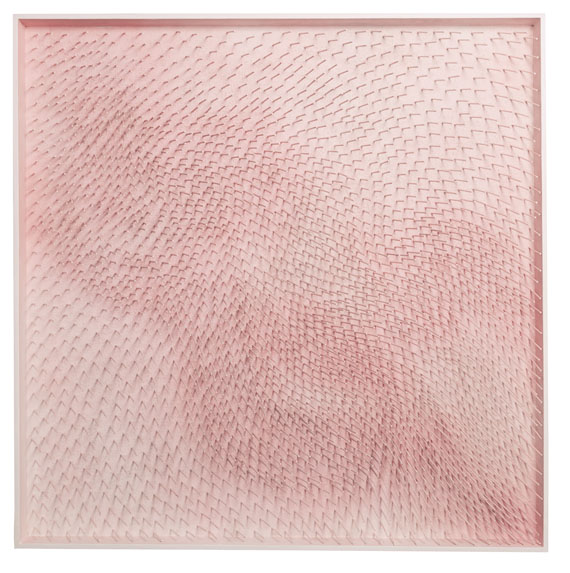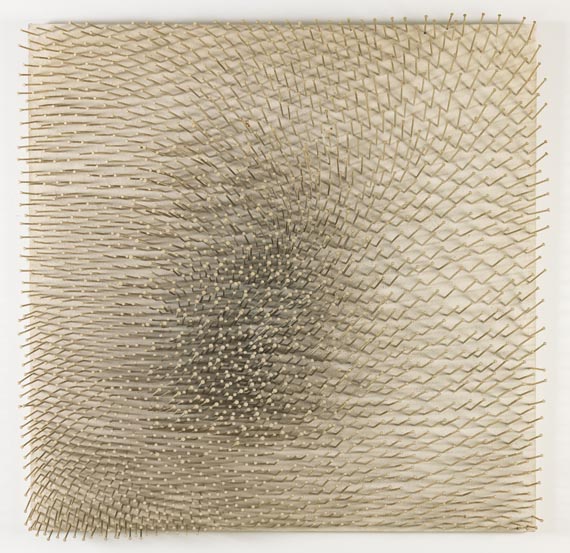62
Günther Uecker
Bewegtes Feld, 1964.
Nails and white paint on canvas, on wood
Estimate:
€ 200,000 - 300,000
$ 214,000 - 321,000
Bewegtes Feld. 1964.
Nails and white paint on canvas, on wood.
Signed, dated, inscribed and with a direction arrow on the reverse. 87 x 87 x 7 cm (34.2 x 34.2 x 2.7 in).
• One of the early nail paintings - of art-historical significance.
• The year 1964 marked Günther Uecker's international breakthrough.
• Comparable works from 1964 are at, among others, the MoMA, New York and Tate Gallery, London.
• Family-owned since it was made.
This work is registered in the Uecker Archive under the number GU.64.123 and has been marked for inclusion into the forthcoming Uecker catalogue raisonné.
PROVENANCE: Galerie Schmela, Düsseldorf.
Private collection North Rhine-Westphalia (directly from the above, family-owned since 1964).
Called up: June 7, 2024 - ca. 19.02 h +/- 20 min.
Nails and white paint on canvas, on wood.
Signed, dated, inscribed and with a direction arrow on the reverse. 87 x 87 x 7 cm (34.2 x 34.2 x 2.7 in).
• One of the early nail paintings - of art-historical significance.
• The year 1964 marked Günther Uecker's international breakthrough.
• Comparable works from 1964 are at, among others, the MoMA, New York and Tate Gallery, London.
• Family-owned since it was made.
This work is registered in the Uecker Archive under the number GU.64.123 and has been marked for inclusion into the forthcoming Uecker catalogue raisonné.
PROVENANCE: Galerie Schmela, Düsseldorf.
Private collection North Rhine-Westphalia (directly from the above, family-owned since 1964).
Called up: June 7, 2024 - ca. 19.02 h +/- 20 min.
In the present work “Weißes Feld” (White Field) from the series of the “Animierte Felder" (Animated Fields), a swirl of nails animates the surface and creates a rhythmic dynamic through the interplay of light and shadow that changes with the vantage point. Seemingly weightless and almost 'fleeting' waves spread across the canvas and take the painting to the third dimension. Especially in his early nail paintings - which are of art-historical significance - Uecker succeeded in breaking an apparent paradox: He removed all notions of rigidity from the nail by arranging it in the play of light; thus creating dense motion patterns that bring the surface in front of our eyes to life. Hence, Uecker's early nail paintings are not only impressive for their unique progressiveness but also because of their beautiful and timeless aesthetic, which allows the white nail heads to float in front of the monochrome canvas, liberating the work's visual effect from the enormously forceful process of its creation. For his early works, Uecker preferred solid and pointed nails of different lengths, which were made of inconspicuous gray metal. The way he uses nails in his creations, usually driving them into square panels covered with canvas, reminds the viewer of their non-aesthetic function. The nailing does not follow a meticulous order, it forms spirals reminiscent of swirls of hair, whirlpools, or mysterious circles. The circle is of central importance in Uecker's work anyway, it provides the beginning of a spiritual and highly concentrated action. Uecker also prefers a monochromatic approach. The mystical effect his works share with those by Yves Klein and Lucio Fontana is mainly due to the use of muted colors. The nails, which the artist usually shows in their natural gray color, come in a light eggshell tone in this case. In some cases Uecker also applies the paint onto the canvas with his fingers before driving in the nails, a direct emotional action for which Uecker dispenses with painting with a brush.
The Düsseldorf artist group ZERO, founded by Heinz Mack and Otto Piene in 1958 and joined by Uecker in 1961, disbanded at the height of its public recognition in November 1966. ZERO brought a revolutionary new beginning to post-war art, embodying a spectacular new artistic concept that rejected all art-historical conventions and sought a purified artistic expression, of which this “White Field” is a prime example. The revolutionary creations of these years conquer space, overcome two-dimensionality and, despite their materiality, achieve subtle aesthetics that incorporate the dynamic and invigorating interplay of light and shadow into the composition. “Zero is silence. Zero is the beginning. Zero is round. Zero revolves. [..] Zero is white” says the ‘ZERO Manifesto’ written by Piene, Mack and Uecker in 1965, and the enchanting aesthetic impression of this work could hardly be more aptly described. Uecker's gesture and style in off-white fascinates and captivates us time and again; the gesture - especially in his early work - is reduced and quiet and at the same time has an indescribable aesthetic presence. [MvL]
The Düsseldorf artist group ZERO, founded by Heinz Mack and Otto Piene in 1958 and joined by Uecker in 1961, disbanded at the height of its public recognition in November 1966. ZERO brought a revolutionary new beginning to post-war art, embodying a spectacular new artistic concept that rejected all art-historical conventions and sought a purified artistic expression, of which this “White Field” is a prime example. The revolutionary creations of these years conquer space, overcome two-dimensionality and, despite their materiality, achieve subtle aesthetics that incorporate the dynamic and invigorating interplay of light and shadow into the composition. “Zero is silence. Zero is the beginning. Zero is round. Zero revolves. [..] Zero is white” says the ‘ZERO Manifesto’ written by Piene, Mack and Uecker in 1965, and the enchanting aesthetic impression of this work could hardly be more aptly described. Uecker's gesture and style in off-white fascinates and captivates us time and again; the gesture - especially in his early work - is reduced and quiet and at the same time has an indescribable aesthetic presence. [MvL]
62
Günther Uecker
Bewegtes Feld, 1964.
Nails and white paint on canvas, on wood
Estimate:
€ 200,000 - 300,000
$ 214,000 - 321,000
Buyer's premium, taxation and resale right compensation for Günther Uecker "Bewegtes Feld"
This lot can be purchased subject to differential or regular taxation, artist‘s resale right compensation is due.
Differential taxation:
Hammer price up to 800,000 €: herefrom 32 % premium.
The share of the hammer price exceeding 800,000 € is subject to a premium of 27 % and is added to the premium of the share of the hammer price up to 800,000 €.
The share of the hammer price exceeding 4,000,000 € is subject to a premium of 22 % and is added to the premium of the share of the hammer price up to 4,000,000 €.
The buyer's premium contains VAT, however, it is not shown.
Regular taxation:
Hammer price up to 800,000 €: herefrom 27 % premium.
The share of the hammer price exceeding 800,000 € is subject to a premium of 21% and is added to the premium of the share of the hammer price up to 800,000 €.
The share of the hammer price exceeding 4,000,000 € is subject to a premium of 15% and is added to the premium of the share of the hammer price up to 4,000,000 €.
The statutory VAT of currently 19 % is levied to the sum of hammer price and premium. As an exception, the reduced VAT of 7 % is added for printed books.
We kindly ask you to notify us before invoicing if you wish to be subject to regular taxation.
Calculation of artist‘s resale right compensation:
For works by living artists, or by artists who died less than 70 years ago, a artist‘s resale right compensation is levied in accordance with Section 26 UrhG:
4 % of hammer price from 400.00 euros up to 50,000 euros,
another 3 % of the hammer price from 50,000.01 to 200,000 euros,
another 1 % for the part of the sales proceeds from 200,000.01 to 350,000 euros,
another 0.5 % for the part of the sale proceeds from 350,000.01 to 500,000 euros and
another 0.25 % of the hammer price over 500,000 euros.
The maximum total of the resale right fee is EUR 12,500.
The artist‘s resale right compensation is VAT-exempt.
Differential taxation:
Hammer price up to 800,000 €: herefrom 32 % premium.
The share of the hammer price exceeding 800,000 € is subject to a premium of 27 % and is added to the premium of the share of the hammer price up to 800,000 €.
The share of the hammer price exceeding 4,000,000 € is subject to a premium of 22 % and is added to the premium of the share of the hammer price up to 4,000,000 €.
The buyer's premium contains VAT, however, it is not shown.
Regular taxation:
Hammer price up to 800,000 €: herefrom 27 % premium.
The share of the hammer price exceeding 800,000 € is subject to a premium of 21% and is added to the premium of the share of the hammer price up to 800,000 €.
The share of the hammer price exceeding 4,000,000 € is subject to a premium of 15% and is added to the premium of the share of the hammer price up to 4,000,000 €.
The statutory VAT of currently 19 % is levied to the sum of hammer price and premium. As an exception, the reduced VAT of 7 % is added for printed books.
We kindly ask you to notify us before invoicing if you wish to be subject to regular taxation.
Calculation of artist‘s resale right compensation:
For works by living artists, or by artists who died less than 70 years ago, a artist‘s resale right compensation is levied in accordance with Section 26 UrhG:
4 % of hammer price from 400.00 euros up to 50,000 euros,
another 3 % of the hammer price from 50,000.01 to 200,000 euros,
another 1 % for the part of the sales proceeds from 200,000.01 to 350,000 euros,
another 0.5 % for the part of the sale proceeds from 350,000.01 to 500,000 euros and
another 0.25 % of the hammer price over 500,000 euros.
The maximum total of the resale right fee is EUR 12,500.
The artist‘s resale right compensation is VAT-exempt.




 Lot 62
Lot 62 


